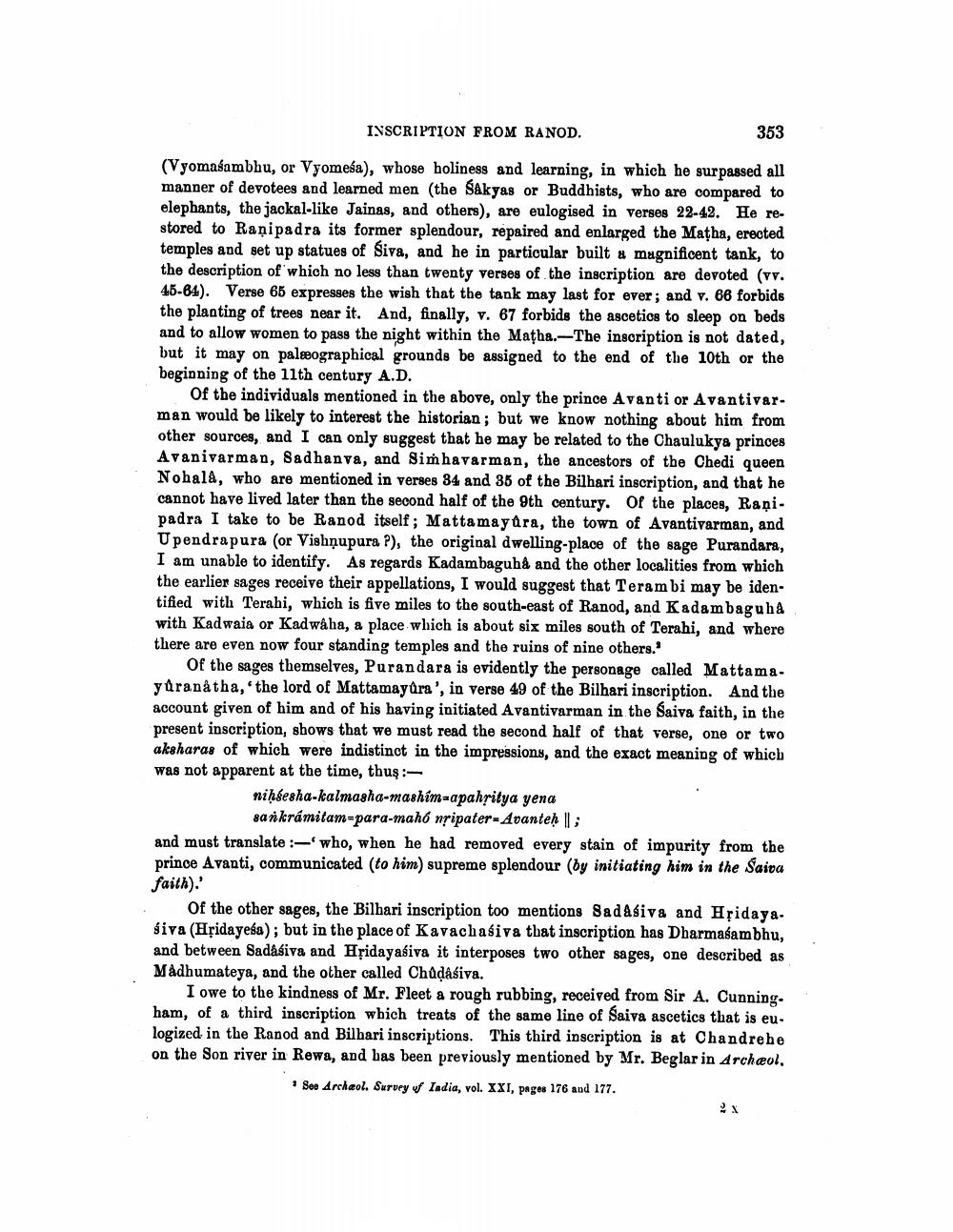________________
INSCRIPTION FROM RANOD.
353
(Vyomasambhu, or Vyomesa), whose holiness and learning, in which he surpassed all manner of devotees and learned men (the Sakyas or Buddhists, who are compared to elephants, the jackal-like Jainas, and others), are eulogised in verses 22-42. He restored to Ranipadra its former splendour, repaired and enlarged the Matha, erected temples and set up statues of Siva, and he in particular built a magnificent tank, to the description of which no less than twenty verses of the inscription are devoted (vv. 45-64). Verse 65 expresses the wish that the tank may last for ever; and v. 66 forbids the planting of trees near it. And, finally, v. 67 forbids the ascetics to sleep on beds and to allow women to pass the night within the Matha. The inscription is not dated, but it may on palæographical grounds be assigned to the end of the 10th or the beginning of the 11th century A.D.
Of the individuals mentioned in the above, only the prince Avanti or Avantivarman would be likely to interest the historian; but we know nothing about him from other sources, and I can only suggest that he may be related to the Chaulukya princes Avanivarman, Sadhanva, and Simhavarman, the ancestors of the Chedi queen Nohala, who are mentioned in verses 34 and 35 of the Bilhari inscription, and that he cannot have lived later than the second half of the 9th century. Of the places, Raņipadra I take to be Ranod itself; Mattamayara, the town of Avantivarman, and Upendrapura (or Vishnupura P), the original dwelling-place of the sage Purandara, I am unable to identify. As regards Kadambaguha and the other localities from which the earlier sages receive their appellations, I would suggest that Terambi may be identified with Terahi, which is five miles to the south-east of Ranod, and Kadambaguha with Kadwaia or Kadwaha, a place which is about six miles south of Terahi, and where there are even now four standing temples and the ruins of nine others."
Of the sages themselves, Purandara is evidently the personage called Mattama. yaranátha, 'the lord of Mattamayura', in verse 49 of the Bilhari inscription. And the account given of him and of his having initiated Avantivarman in the Saiva faith, in the present inscription, shows that we must read the second half of that verse, one or two aksharas of which were indistinct in the impressions, and the exact meaning of which was not apparent at the time, thuş :
nihesha-kalmasha-mashim-apahritya yena
sankrámitam-para-maho nripater-Avanteh I; and must translate :- who, when he had removed every stain of impurity from the prince Avanti, communicated (to him) supreme splendour (by initiating him in the Saida faith).'
Of the other sages, the Bilhari inscription too mentions Sadasiva and Hșidaya. śiva (Hridayeśa); but in the place of Kavachaśiva that inscription has Dharmasambhu, and between Sadasiva and Hridayaśiva it interposes two other sages, one described as Madhumateya, and the other called Chudasiva.
I owe to the kindness of Mr. Fleet a rough rubbing, received from Sir A. Cunning. ham, of a third inscription which treats of the same line of Saiva ascetics that is eu. logized in the Ranod and Bilhari inscriptions. This third inscription is at Chandrehe on the Son river in Rewa, and bas been previously mentioned by Mr. Beglar in Archeol.
• Seo Archæol. Survey v India, vol. XXI, pages 176 and 177.




